2011 PEUGEOT 207 remove seats
[x] Cancel search: remove seatsPage 20 of 248

18
Limit the causes of excess
consumption
Spread loads throughout the vehicle;
place the heaviest items in the bottom
of the boot, as close as possible to the
rear seats.
Limit the loads carried in the vehicle
and reduce wind resistance (roof bars,
roof rack, bicycle carrier, trailer...). Use
a roof box in preference.
Remove roof bars and roof racks after
use.
At the end of winter, remove snow
tyres and refi t your summer tyres.
Observe the recommendations
on maintenance
Check the tyre pressures regularly,
when cold, referring to the label in the
door aperture, driver's side.
Carry out this check in particular:
- before a long journey,
- at each change of season,
- after a long period out of use.
Don't forget the spare wheel and the
tyres on any trailer or caravan.
Have your vehicle serviced regularly (en-
gine oil, oil fi lter, air fi lter...) and observe the
schedule of operations recommended by
the manufacturer.
When refuelling, do not continue after
the 3 rd cut-off of the nozzle to avoid
any overfl ow.
At the wheel of your new vehicle, it is only
after the fi rst 1 800 miles (3 000 kilome-
tres) that you will see the fuel consumption
settle down to a consistent average.
Page 55 of 248
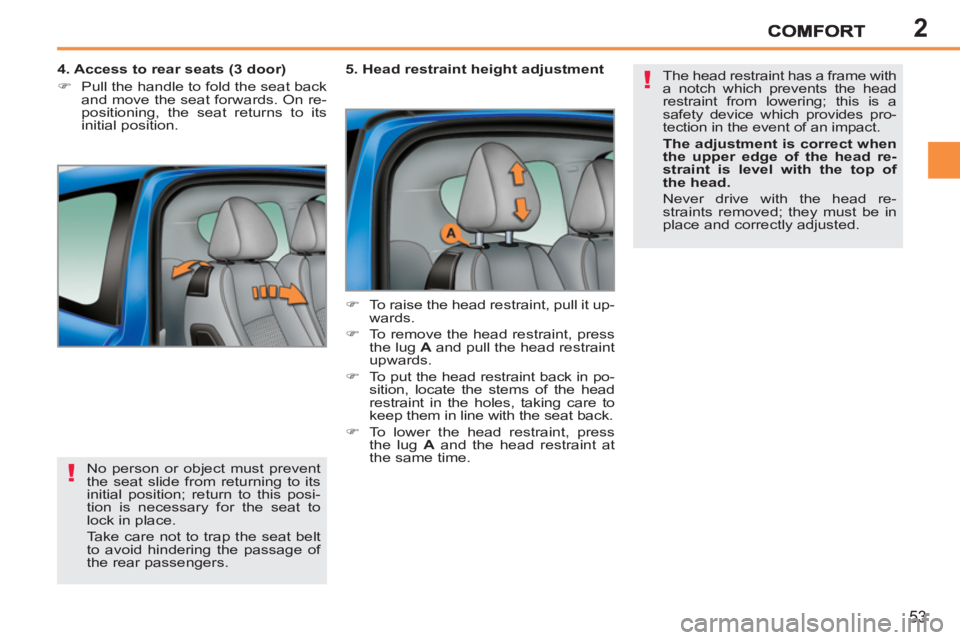
2
!
!
53
No person or object must prevent
the seat slide from returning to its
initial position; return to this posi-
tion is necessary for the seat to
lock in place.
Take care not to trap the seat belt
to avoid hindering the passage of
the rear passengers.
4. Access to rear seats (3 door)
�)
Pull the handle to fold the seat back
and move the seat forwards. On re-
positioning, the seat returns to its
initial position.
5. Head restraint height adjustment
�)
To raise the head restraint, pull it up-
wards.
�)
To remove the head restraint, press
the lug A
and pull the head restraint
upwards.
�)
To put the head restraint back in po-
sition, locate the stems of the head
restraint in the holes, taking care to
keep them in line with the seat back.
�)
To lower the head restraint, press
the lug A
and the head restraint at
the same time. The head restraint has a frame with
a notch which prevents the head
restraint from lowering; this is a
safety device which provides pro-
tection in the event of an impact.
The adjustment is correct when
the upper edge of the head re-
straint is level with the top of
the head.
Never drive with the head re-
straints removed; they must be in
place and correctly adjusted.
Page 56 of 248
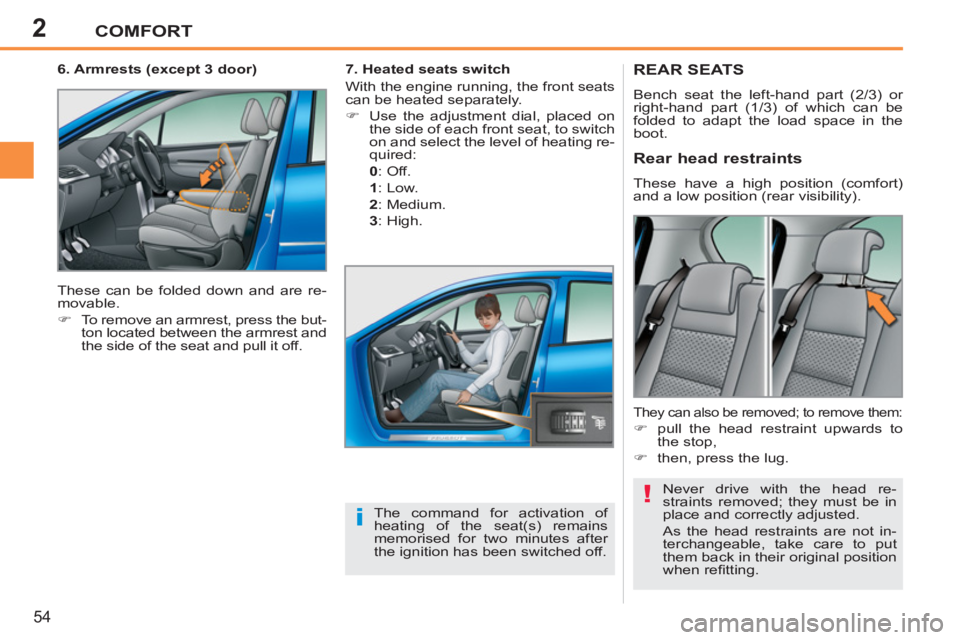
2
!
i
COMFORT
54
REAR SEATS
Bench seat the left-hand part (2/3) or
right-hand part (1/3) of which can be
folded to adapt the load space in the
boot.
Never drive with the head re-
straints removed; they must be in
place and correctly adjusted.
As the head restraints are not in-
terchangeable, take care to put
them back in their original position
when refi tting.
Rear head restraints
These have a high position (comfort)
and a low position (rear visibility).
The command for activation of
heating of the seat(s) remains
memorised for two minutes after
the ignition has been switched off.
7. Heated seats switch
With the engine running, the front seats
can be heated separately.
�)
Use the adjustment dial, placed on
the side of each front seat, to switch
on and select the level of heating re-
quired:
0
:
Off.
1
:
Low.
2
:
Medium.
3
:
High.
They can also be removed; to remove them:
�)
pull the head restraint upwards to
the stop,
�)
then, press the lug.
6. Armrests (except 3 door)
These can be folded down and are re-
movable.
�)
To remove an armrest, press the but-
ton located between the armrest and
the side of the seat and pull it off.
Page 66 of 248
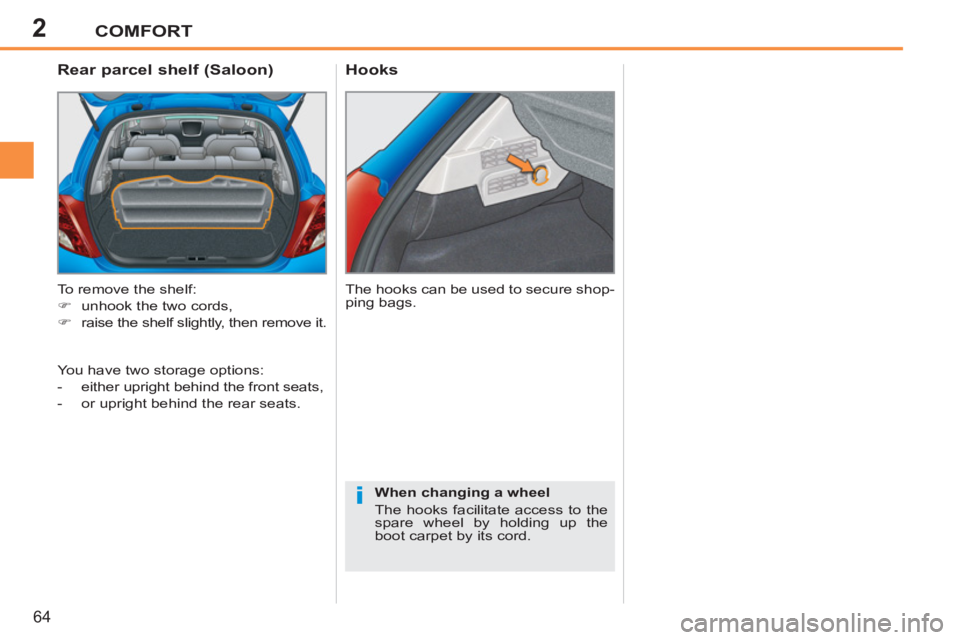
2
i
COMFORT
64
Hooks
Rear parcel shelf (Saloon)
To remove the shelf:
�)
unhook the two cords,
�)
raise the shelf slightly, then remove it. The hooks can be used to secure shop-
ping bags.
When changing a wheel
The hooks facilitate access to the
spare wheel by holding up the
boot carpet by its cord.
You have two storage options:
- either upright behind the front seats,
- or upright behind the rear seats.
Page 68 of 248
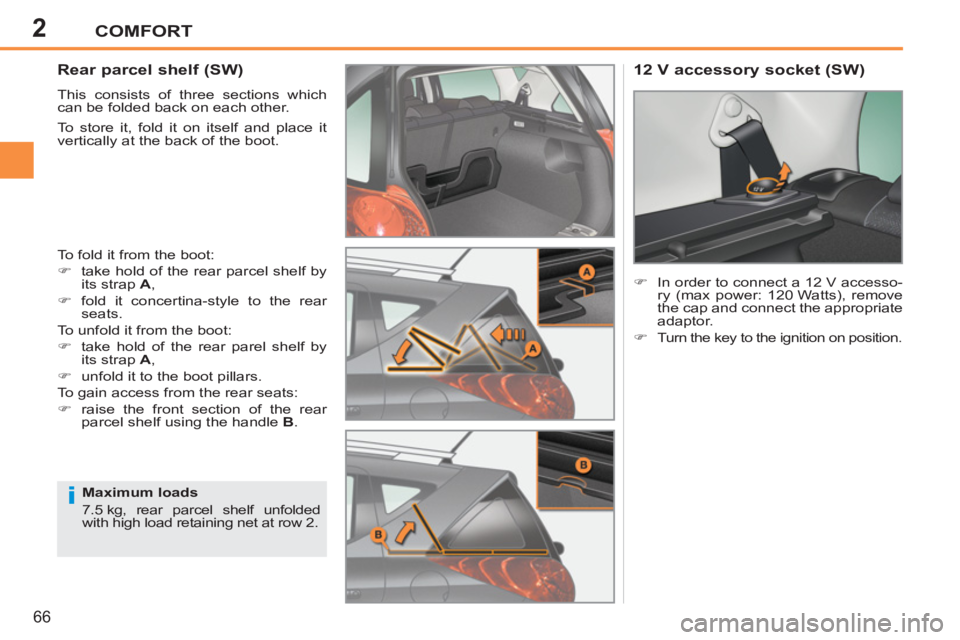
2
i
COMFORT
66
Rear parcel shelf (SW)
This consists of three sections which
can be folded back on each other.
To store it, fold it on itself and place it
vertically at the back of the boot.
To fold it from the boot:
�)
take hold of the rear parcel shelf by
its strap A
,
�)
fold it concertina-style to the rear
seats.
To unfold it from the boot:
�)
take hold of the rear parel shelf by
its strap A
,
�)
unfold it to the boot pillars.
To gain access from the rear seats:
�)
raise the front section of the rear
parcel shelf using the handle B
.
12 V accessory socket (SW)
�)
In order to connect a 12 V accesso-
ry (max power: 120 Watts), remove
the cap and connect the appropriate
adaptor.
�)
Turn the key to the ignition on position.
Maximum loads
7.5 kg, rear parcel shelf unfolded
with high load retaining net at row 2.
Page 69 of 248
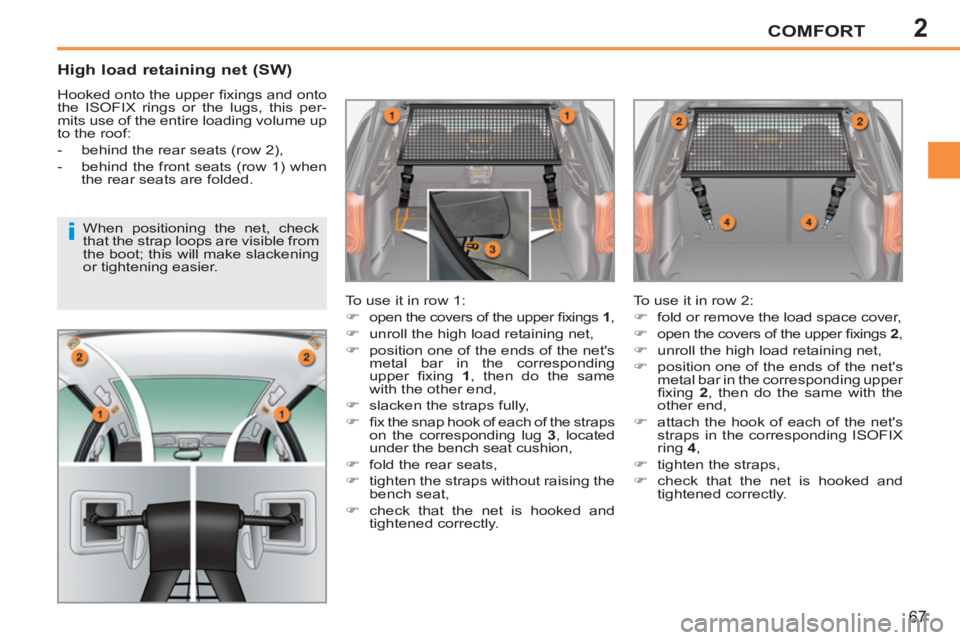
2
i
COMFORT
67
High load retaining net (SW)
Hooked onto the upper fi xings and onto
the ISOFIX rings or the lugs, this per-
mits use of the entire loading volume up
to the roof:
- behind the rear seats (row 2),
- behind the front seats (row 1) when
the rear seats are folded.
To use it in row 1:
�)
open the covers of the upper fi xings 1
,
�)
unroll the high load retaining net,
�)
position one of the ends of the net's
metal bar in the corresponding
upper fi xing 1
, then do the same
with the other end,
�)
slacken the straps fully,
�)
fi x the snap hook of each of the straps
on the corresponding lug 3
, located
under the bench seat cushion,
�)
fold the rear seats,
�)
tighten the straps without raising the
bench seat,
�)
check that the net is hooked and
tightened correctly. To use it in row 2:
�)
fold or remove the load space cover,
�)
open the covers of the upper fi xings 2
,
�)
unroll the high load retaining net,
�)
position one of the ends of the net's
metal bar in the corresponding upper
fi xing 2
, then do the same with the
other end,
�)
attach the hook of each of the net's
straps in the corresponding ISOFIX
ring 4
,
�)
tighten the straps,
�)check that the net is hooked and
tightened correctly.
When positioning the net, check
that the strap loops are visible from
the boot; this will make slackening
or tightening easier.
Page 75 of 248
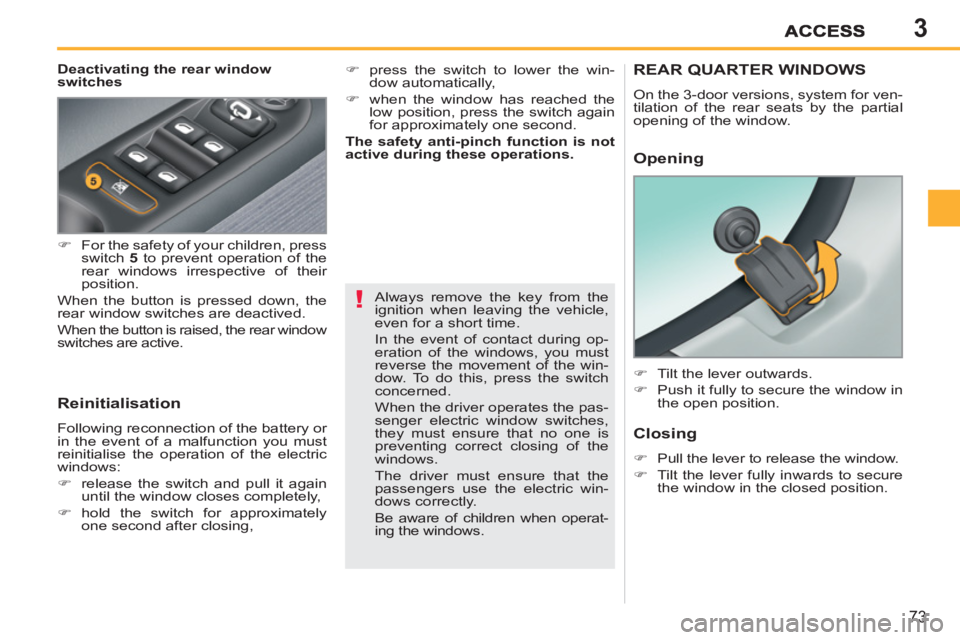
3
!
73
Deactivating the rear window
switches
Reinitialisation
Following reconnection of the battery or
in the event of a malfunction you must
reinitialise the operation of the electric
windows:
�)
release the switch and pull it again
until the window closes completely,
�)
hold the switch for approximately
one second after closing, Always remove the key from the
ignition when leaving the vehicle,
even for a short time.
In the event of contact during op-
eration of the windows, you must
reverse the movement of the win-
dow. To do this, press the switch
concerned.
When the driver operates the pas-
senger electric window switches,
they must ensure that no one is
preventing correct closing of the
windows.
The driver must ensure that the
passengers use the electric win-
dows correctly.
Be aware of children when operat-
ing the windows.
REAR QUARTER WINDOWS
On the 3-door versions, system for ven-
tilation of the rear seats by the partial
opening of the window.
Opening
�)
For the safety of your children, press
switch 5
to prevent operation of the
rear windows irrespective of their
position.
When the button is pressed down, the
rear window switches are deactived.
When the button is raised, the rear window
switches are active.
Closing
�)
Pull the lever to release the window.
�)
Tilt the lever fully inwards to secure
the window in the closed position.
�)
Tilt the lever outwards.
�)
Push it fully to secure the window in
the open position.
�)
press the switch to lower the win-
dow automatically,
�)
when the window has reached the
low position, press the switch again
for approximately one second.
The safety anti-pinch function is not
active during these operations.
Page 100 of 248
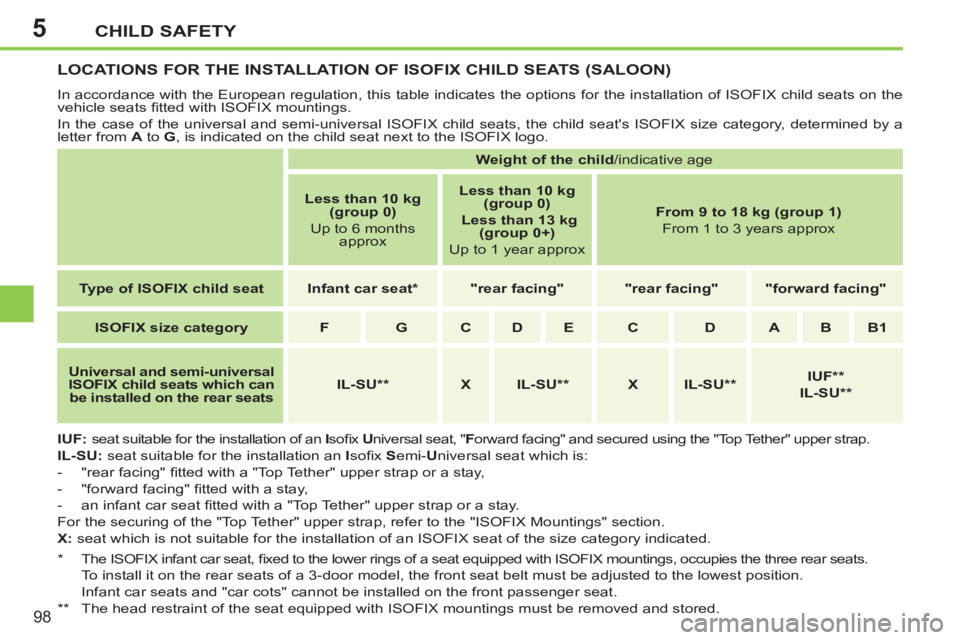
5CHILD SAFETY
98
LOCATIONS FOR THE INSTALLATION OF ISOFIX CHILD SEATS (SALOON)
In accordance with the European regulation, this table indicates the options for the installation of ISOFIX child seats on the
vehicle seats fi tted with ISOFIX mountings.
In the case of the universal and semi-universal ISOFIX child seats, the child seat's ISOFIX size category, determined by a
letter from A
to G
, is indicated on the child seat next to the ISOFIX logo.
IUF:
seat suitable for the installation of an I
sofi x U
niversal seat, " F
orward facing" and secured using the "Top Tether" upper strap.
IL-SU:
seat suitable for the installation an I
sofi x S
emi- U
niversal seat which is:
- "rear facing" fi tted with a "Top Tether" upper strap or a stay,
- "forward facing" fi tted with a stay,
- an infant car seat fi tted with a "Top Tether" upper strap or a stay.
For the securing of the "Top Tether" upper strap, refer to the "ISOFIX Mountings" section.
X:
seat which is not suitable for the installation of an ISOFIX seat of the size category indicated.
Weight of the child
/indicative age
Less than 10 kg
(group 0)
Up to 6 months
approx
Less than 10 kg
(group 0)
Less than 13 kg
(group 0+)
Up to 1 year approx
From 9 to 18 kg (group 1)
From 1 to 3 years approx
Type of ISOFIX child seat
Infant car seat *
"rear facing"
"rear facing"
"forward facing"
ISOFIX size category
F
G
C
D
E
C
D
A
B
B1
Universal and semi-universal
ISOFIX child seats which can
be installed on the rear seats
IL-SU **
X
IL-SU **
X
IL-SU **
IUF **
IL-SU **
*
The ISOFIX infant car seat, fi xed to the lower rings of a seat equipped with ISOFIX mountings, occupies the three rear seats.
To install it on the rear seats of a 3-door model, the front seat belt must be adjusted to the lowest position.
Infant car seats and "car cots" cannot be installed on the front passenger seat.
**
The head restraint of the seat equipped with ISOFIX mountings must be removed and stored.